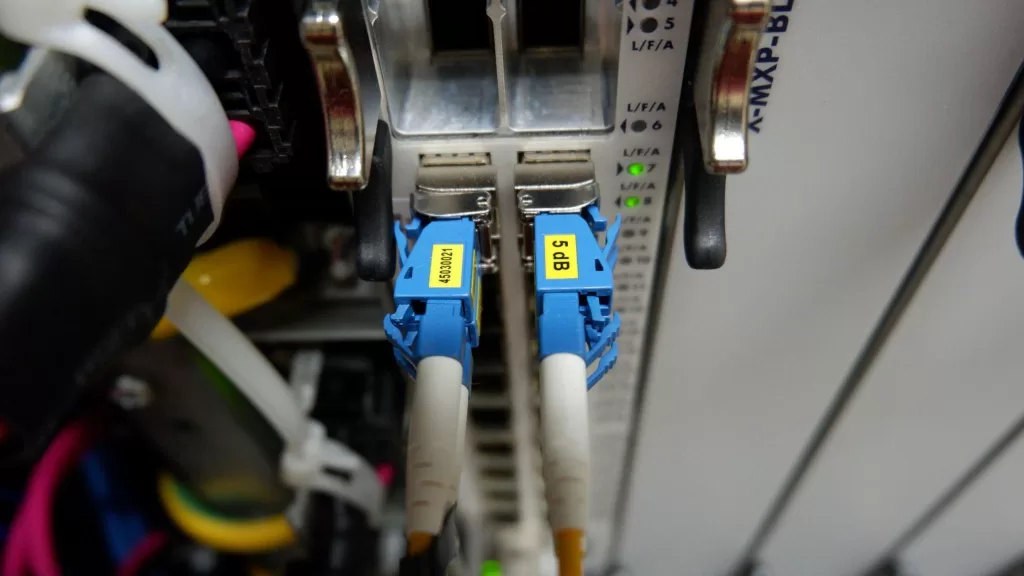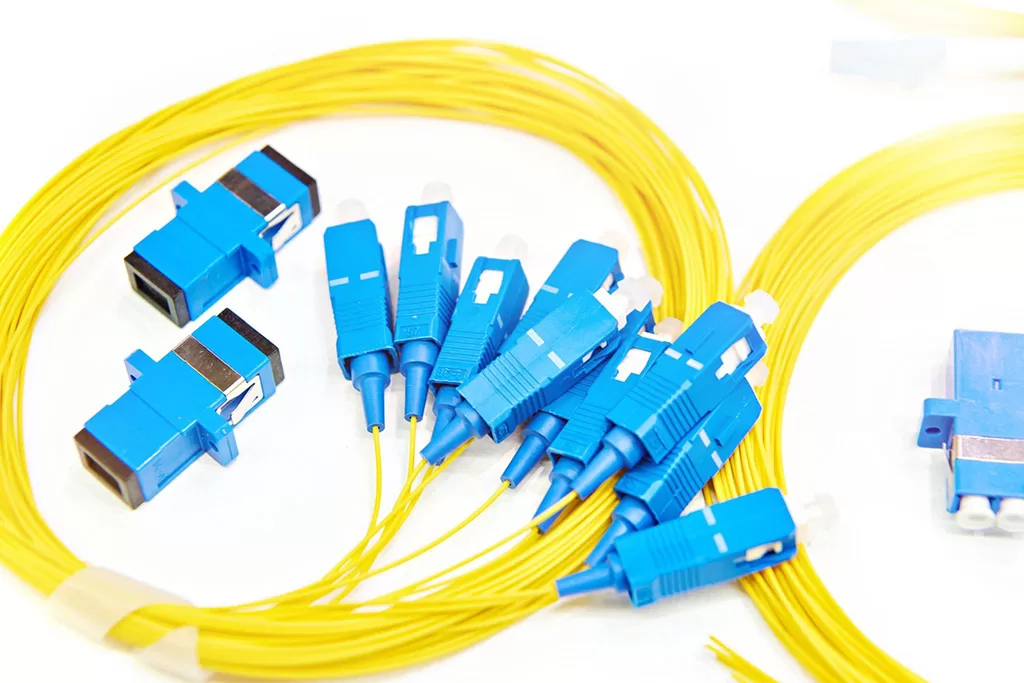
Fiber optic adapters and optical fiber attenuators are both passive fiber optic components, but they have different functions.
Glasvezeladapters
Fiber optic adapters are passive fiber optic components used to connect two fiber optic cables together. They are typically used in fiber optic networks to connect different types of fiber optic cables, such as single-mode and multimode cables, or to connect cables with different connector types, such as LC and SC connectors.
Fiber optic adapters have two main functions:
- To align the two fiber optic cores precisely, so that light can be transmitted efficiently from one cable to the other.
- To protect the fiber optic cores from damage.
Fiber optic adapters are available in a variety of types, each designed for a specific application. The most common types of fiber optic adapters include:
- LC adapters: LC adapters are the most popular type of fiber optic adapter in use today. They are small, lightweight, and easy to use.
- SC adapters: SC adapters are another popular type of fiber optic adapter. They are slightly larger than LC adapters, but they are also more rugged.
- FC adapters: FC adapters are an older type of fiber optic adapter, but they are still used in some applications. They are larger and more rugged than LC and SC adapters, but they are also more difficult to use.
- ST adapters: ST adapters are another older type of fiber optic adapter. They are similar to FC adapters, but they have a bayonet connector that makes them easier to use.
Optische vezelverzwakkers

Optical fiber attenuators are passive fiber optic components used to reduce the power level of an optical signal. They are typically used in fiber optic networks to prevent overloading of the receiving fiber, or to equalize the power levels between two fibers.
Optical fiber attenuators work by absorbing or scattering some of the light in the optical signal. This reduces the power of the signal, but it does not distort the signal.
Optical fiber attenuators are available in a variety of types, each designed for a specific application. The most common types of optical fiber attenuators include:
- Fixed attenuators: Fixed attenuators have a pre-set attenuation level that cannot be changed.
- Variable attenuators: Variable attenuators allow the attenuation level to be adjusted.
- In-line attenuators: In-line attenuators are typically inserted into a fiber optic cable to reduce the power level of the signal.
- Bulkhead attenuators: Bulkhead attenuators are typically mounted on a panel or bulkhead to reduce the power level of the signal.

Here is a table that summarizes the key differences between fiber optic adapters and optical fiber attenuators:
| Characteristic | Fiber optic adapter | Optical fiber attenuator |
|---|---|---|
| Function | Connects two fiber optic cables together | Reduces the power level of an optical signal |
| Typical applications | Connecting different types of fiber optic cables or cables with different connector types | Preventing overloading of the receiving fiber or equalizing the power levels between two fibers |
| Physical appearance | Typically has two connectors, one on each end | Can have a variety of physical appearances, but they often look similar to fiber optic adapters |
Application Comparison
Fiber optic adapters and optical fiber attenuators are both used in fiber optic networks, but they have different applications.
Fiber optic adapters are used to connect two fiber optic cables together. This is necessary when connecting different types of fiber optic cables, or when connecting cables with different connector types.
Optical fiber attenuators are used to reduce the power level of an optical signal. This is necessary to prevent overloading of the receiving fiber, or to equalize the power levels between two fibers.

Here are some examples of when fiber optic adapters and optical fiber attenuators might be used:
- Fiber optic adapters might be used to connect a single-mode fiber optic cable from one network to a multimode fiber optic cable from another network.
- Optical fiber attenuators might be used to reduce the power level of an optical signal before it is transmitted through a long-distance fiber optic cable.
- Fiber optic adapters might be used to connect a fiber optic cable to a fiber optic patch panel.
- Optical fiber attenuators might be used to reduce the power level of an optical signal before it is input into a fiber optic receiver.
Design Considerations
When choosing fiber optic adapters and optical fiber attenuators, there are a number of factors to consider, including:
- The type of fiber optic cable being used (single-mode or multimode)
- The connector type on the fiber optic cables
- The desired attenuation level (for optical fiber attenuators)
- The operating environment
It is also important to choose fiber optic adapters and optical fiber attenuators that are compatible with each other. For example, you cannot use an LC adapter to connect a fiber optic cable with an SC connector.
Conclusie
Fiber optic adapters and optical fiber attenuators are both important components in fiber optic networks. Fiber optic adapters are used to connect two fiber optic cables together, while optical fiber attenuators are used to reduce the power level of an optical signal.
When choosing fiber optic adapters and optical fiber attenuators, it is important to consider the type of fiber optic cable being used, the connector type on the fiber optic cables, the desired attenuation level (for optical fiber attenuators), and the operating environment.
It is important to note that some optical fiber attenuators are designed to look like fiber optic adapters. This is because it can be convenient to have an attenuator that can be easily inserted into a fiber optic network without having to splice or terminate any cables. However, it is important to be aware of the difference between the two types of components, so that you can select the right one for your application.